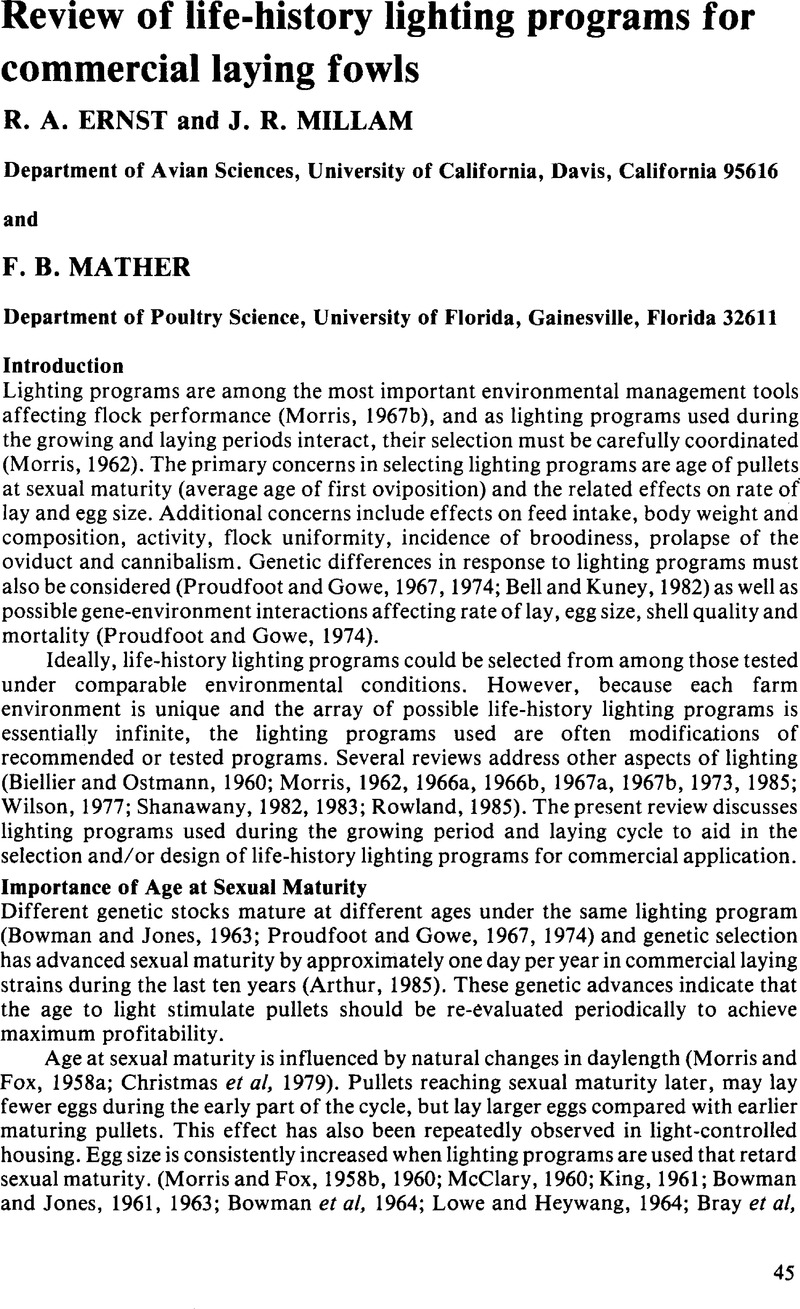Crossref Citations
This article has been cited by the following publications. This list is generated based on data provided by Crossref.
BRAKE, J.
and
BAUGHMAN, G.R.
1989.
Comparison of Lighting Regimens During Growth on Subsequent Seasonal Reproductive Performance of Broiler Breeders.
Poultry Science,
Vol. 68,
Issue. 1,
p.
79.
BRAKE, J.
GARLICH, J.D.
and
BAUGHMAN, G.R.
1989.
Effects of Lighting Program During the Growing Period and Dietary Fat During the Laying Period on Broiler Breeder Performance.
Poultry Science,
Vol. 68,
Issue. 9,
p.
1185.
EITAN, Y.
and
SOLLER, M.
1991.
Two-Way Selection for Threshold Body Weight at First Egg in Broiler Strain Females..
Poultry Science,
Vol. 70,
Issue. 10,
p.
2017.
Yalcin, S.
McDaniel, G.R.
and
Wong-Valle, J.
1993.
Effect of Preproduction Lighting Regimes on Reproductive Performance of Broiler Breeders.
Journal of Applied Poultry Research,
Vol. 2,
Issue. 1,
p.
51.
Boshouwers, F. M. G.
and
Nicaise, Elly
1993.
Artificial light sources and their influence on physical activity and energy expenditure of laying hens.
British Poultry Science,
Vol. 34,
Issue. 1,
p.
11.
YUAN, T.
LIEN, R.J.
and
McDANIEL, G.R.
1994.
Effects of Increased Rearing Period Body Weights and Early Photostimulation on Broiler Breeder Egg Production ,.
Poultry Science,
Vol. 73,
Issue. 6,
p.
792.
Vandenberghe, N
Ceular, AL
and
Moreno, A
1999.
Use of hatch date for broiler breeder production planning.
Poultry Science,
Vol. 78,
Issue. 4,
p.
501.
Eitan, Y.
and
Soller, M.
2000.
Two-way selection for high and low responsiveness to photostimulation in broiler strain males.
Poultry Science,
Vol. 79,
Issue. 9,
p.
1227.
Harms, R.H.
Motl, M.A.
and
Russell, G.B.
2000.
Influence of Age at Lighting, Dietary Calcium, and Addition of Corn Oil on Early Egg Weight.
Journal of Applied Poultry Research,
Vol. 9,
Issue. 3,
p.
334.
Eitan, Y.
and
Soller, M.
2001.
Effect of Photoperiod and Quantitative Feed Restriction in a Broiler Strain on Onset of Lay in Females and Onset of Semen Production in Males: a Genetic Hypothesis.
Poultry Science,
Vol. 80,
Issue. 10,
p.
1397.
Gewehr, Clóvis Eliseu
Cotta, Judas Tadeu de Barros
Oliveira, Antonio Ilson Gomes de
and
Freitas, Henrique Jorge de
2005.
Efeitos de programas de iluminação na produção de ovos de codornas (Coturnix coturnix).
Ciência e Agrotecnologia,
Vol. 29,
Issue. 4,
p.
857.
2006.
Introducing Biological Rhythms.
p.
341.
Jácome, IMTD
Rossi, LA
and
Borille, R
2014.
Influence of artificial lighting on the performance and egg quality of commercial layers: a review.
Revista Brasileira de Ciência Avícola,
Vol. 16,
Issue. 4,
p.
337.
Podkowa, Paweł
and
Surmacki, Adrian
2017.
The importance of illumination in nest site choice and nest characteristics of cavity nesting birds.
Scientific Reports,
Vol. 7,
Issue. 1,
Hieke, Anne-Sophie Charlotte
Hubert, Shawna Marie
and
Athrey, Giridhar
2019.
Circadian disruption and divergent microbiota acquisition under extended photoperiod regimens in chicken.
PeerJ,
Vol. 7,
Issue. ,
p.
e6592.
Souza, C
Bedin, AFS
and
Gewehr, CE
2023.
Lighting Programs of White Layers Hens in Start Phase Production.
Brazilian Journal of Poultry Science,
Vol. 25,
Issue. 4,



